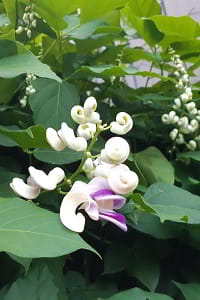Notes from Gerard's Garden

How do you harvest seed?
When you live on a large rural section and enjoy gardening as one of your pastimes
and by sheer coincidence run a seed company, the temptation to grow and harvest
a few lines of seed that are otherwise difficult to source is too hard to resist.
So it comes to pass that our home garden always includes in-season vegetables for the dinner table, a bed of cutting flowers (this year zinnias and statice) and experimental crops from which to gain experience.
The remainder? Chock full of plants for harvesting seed......

Soybean was a new crop grown to become more familiar with it, to understand its life cycle, the distance needed between plants, plant height, what bugs and diseases were attracted to it and how it coped with minimal input once sown.
Most gardeners around the country should be able to grow it, as long as it's not sown too early, perhaps timing it from when the last frosts have passed.

Corn Glass Gem is an impressive ornamental corn that grows to 3 metres tall and has many side tillers which means it needs twice the space you’d allow for a standard sweetcorn. Each plant produces up to 5 cobs and they have an exquisite array of colours, each plant different to the next.
Considering its height, it stood up well to the early summer winds.
Not only attractive hung in bunches as a dried arrangement but also great as a popping corn.

Caigua is a South American wild cucumber-type, vining plant with large light green palmate leaves that bear a passing resemblance to Cannabis leaves. The vigorous summer vines produce numerous 7 – 7.5 cm pods that have a pleasant mild cucumber flavour for a quick garden snack.
When split open, they also double as a refreshing and soothing hand and face rub at the end of the gardening day. We have it growing over a piece of trellis but it could also grow happily rambling over a rock wall or down a bank. At harvest stage, the pods lose all their internal pith and the seed cavity hollows leaving mature corky black seeds.

The Snail Vine is a favourite of mine rewarding us right through summer with uniquely shaped beautiful flowers that have an alluring fragrance much like the tropical frangipani. The original seed came from my aunt's garden where it hung over a white picket fence in front of her Mt Albert, Auckland villa. The seed pods that form post-flowering are very slow to ripen, hanging in bunches for several months before filling out and browning off. They can be funny things though and a mature pod doesn’t guarantee a full set of viable plump seeds inside.

Echinacea commands a prime position in our summer garden bordering the car park. It provides many months of colourful daisy like flowers that bees and beneficial insects thrive on. When they finally lose their petals, prickly starball like heads remain in their place and caution needs to be exercised as well as good leather gloves for harvesting purposes!
Up the back of the garden, and inside a bird netting covered enclosure, is our Blueberry patch, an assortment of 6 different cultivars to help spread the flush of berries over a long harvest period. The netting serves not only to keep the birds out but also our black Labrador Chester who's developed a taste for them, in addition to cherry tomatoes and strawberries, just within reach of his shiny black nose.....
One of the permanent features of our garden is a bed of Gloriosa Lilies – the national flower of Zimbabwe. They have been really successful this year due to the fact that I’ve finally given them enough support to grow up straight rather than to reach half their potential height then flop over and continue to grow up with a big kink in the middle. They have an unusual shaped tuber with 2 or more growing points on it that run under the soil 10 – 15 cm deep to find new places to pop up and are a real carefree plant to have in a border providing a zany cut flower mid summer as well.
We also had a patch of Florence Fennel that reached maturity and then went past it before we managed to eat it all. Rather than dig it out, it was left to provide some much welcomed nectar and pollen for all the beneficial insects in our garden. From mid-morning on, it would be swarming with bees and tiny wasps getting their 5 + a day.
Despite it being quite wet in spring, followed by a rather dry summer, our well composted and well drained garden grew very healthy plants resulting in a good harvest with very few disease and pest problems. The old adage "They’re only as good as you feed 'em" still rings true!























































